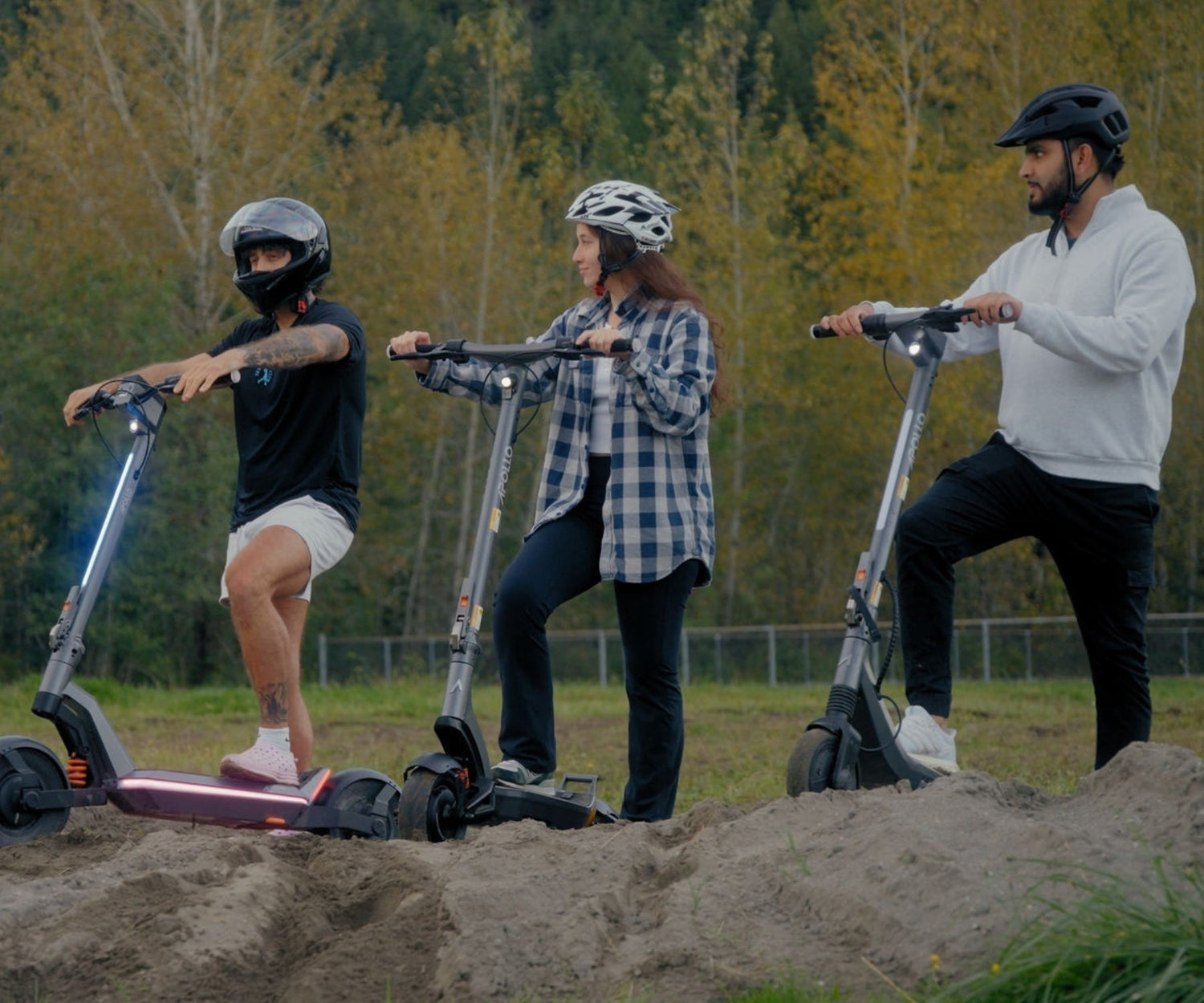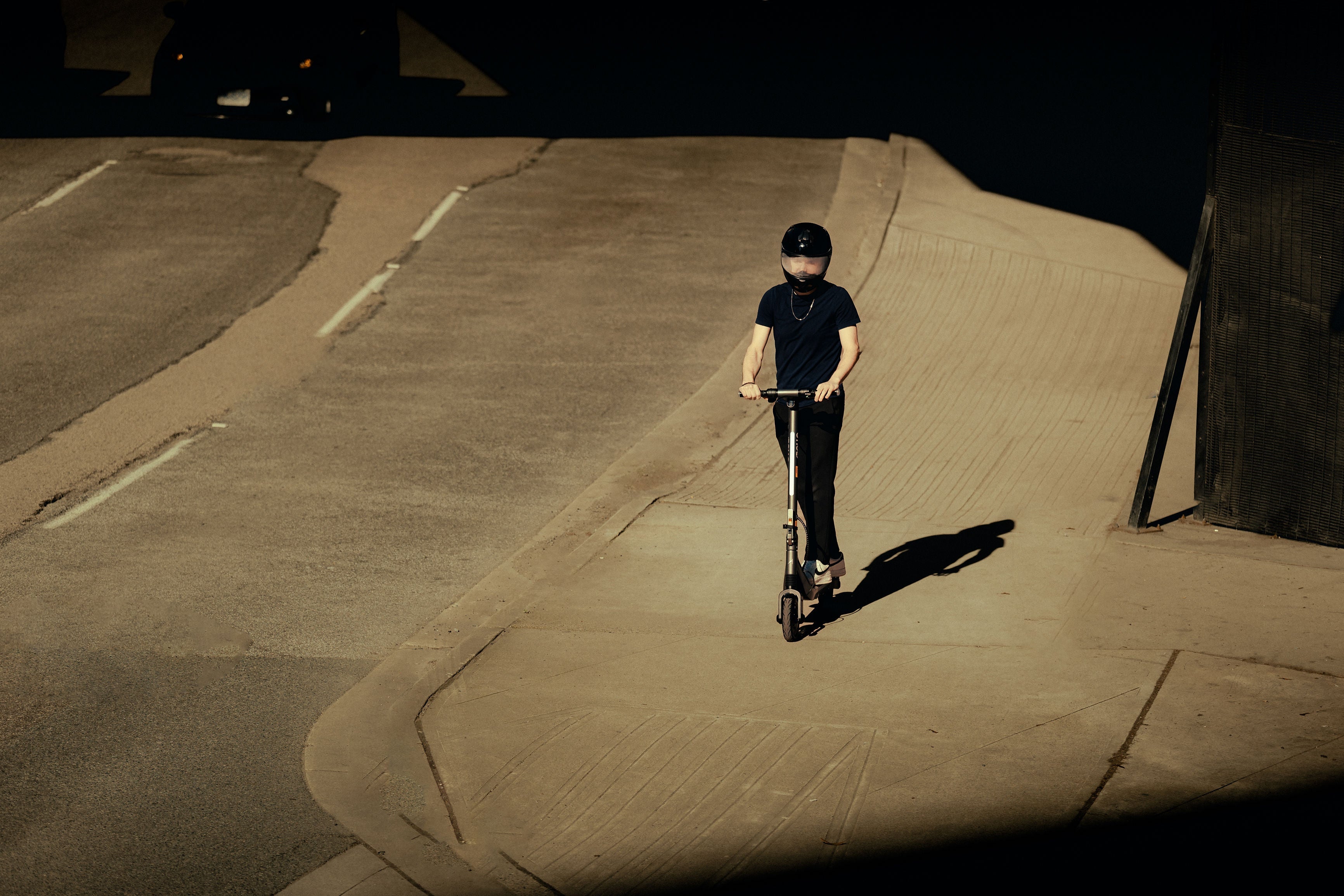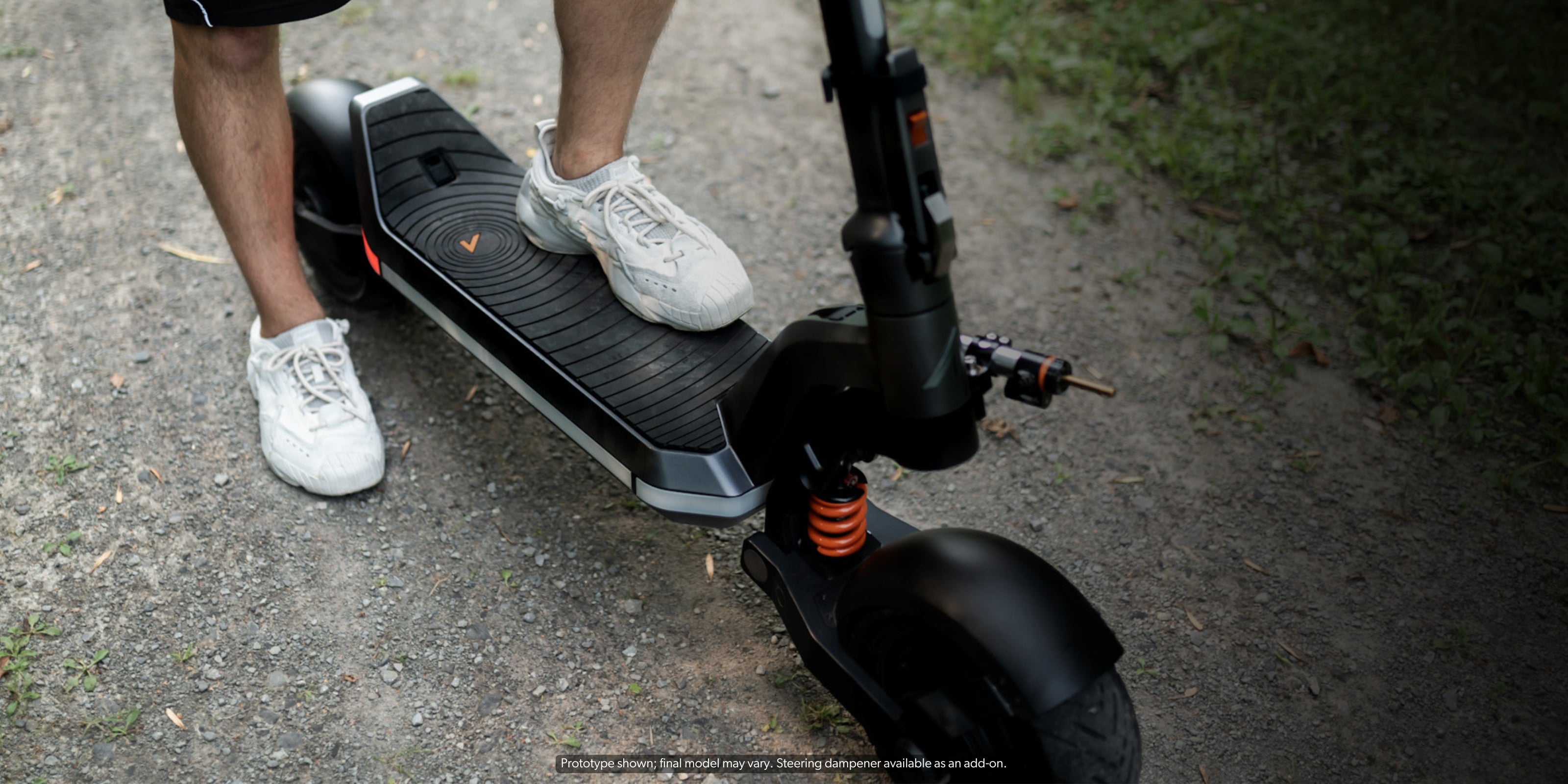Electric scooters come in many different configurations and price points. These are exciting times for commuters, recreational users, and enthusiasts. When looking for a new scooter - whether your first one or second one - one of the features that you may have questions about is the suspension - or lack of. A question we all ask ourselves when we’re first learning about scooters is what is suspension in electric scooters, and why is it important?
In this blog we will talk about the reasons to have suspension, or not, as well as the different suspension configurations and options.
|
Full Suspension Scooter with Air-Filled Tires |
No Suspension Scooter with Solid Tires |
|
|
|
On right, Imotion RS midnight, $5,000, 128 pounds. On left, the Volpam Electric Scooter, $300, 25 pounds.
Pictured above are two electric scooters, the first with a very sophisticated suspension system and the second lacking any suspension at all.
Before we delve deeper into the “whys and hows” of suspension, let’s mention a few reasons to manufacture or own a suspension-less electric scooter. What factors should buyers consider when choosing an electric scooter with suspension?
-
Cost: Suspension adds extra parts and complexity to a scooter, there is a cost associated with this.
-
Weight: Suspension adds additional parts and weight to a scooter.
-
Complexity: Suspension components are mechanical parts that can have wear, need adjustments, lubrication, or break - meaning you’ll most likely have to give your scooter more TLC ( more maintenance).
So - should you always choose a scooter with suspension over one without suspension? The answer is not yes or no. For example: for some situations where trips are short, riding conditions are smooth, speeds are low, and where cost, weight, and low maintenance are important, a scooter lacking suspension may be your best option. Another situation could be riding across a college campus with nice bike paths, or as hybrid transport, where one is just trying to get to the bus or train a few blocks.
Suspension's Role: Why Ride Quality Matters Now
So, if it’s not always necessary, then why and when would you choose to get a scooter with suspension?
-
The obvious: Comfort & a Smoother ride.
Let’s talk about ride comfort. Take a scooter like the Volpam above—not to single it out, but as an example of a design with zero shock absorption. With its rigid frame, solid tires, and lack of suspension, every bump, crack, and expansion joint in the pavement is transmitted directly to your hands and feet.
Now, imagine the difference with a scooter that does have suspension. Just like in a car or a bicycle, suspension helps absorb shocks and vibrations, dramatically improving ride quality. The better the suspension, the smoother your ride—minimizing fatigue and making every journey more enjoyable.
-
Better Braking & Handling
Suspension, along with air-filled tires, helps keep the wheels in contact with the road, improving traction, braking performance, and cornering stability. More grip means more control—especially on uneven terrain or wet surfaces.
-
Rolling Over Obstacles with Ease
Scooter wheels are much smaller in diameter than those on cars, motorcycles, or bicycles, making them more susceptible to sudden stops when encountering obstacles like potholes, branches, or road debris. Suspension allows the wheels to deflect upward while maintaining forward momentum, reducing the risk of abrupt stops or being thrown off balance. Air-filled tires also play a role here—anyone who has used solid-wheel roller skates or skateboards knows how even the smallest pebble can bring them to an instant halt. Advances in materials, like urethane and more compliant wheels, have significantly improved safety—and the same principle applies to scooters.
-
Increased Longevity
While suspension adds weight, complexity, and potential maintenance, it also helps extend the lifespan of a scooter. By absorbing shocks and vibrations, suspension reduces strain on key components such as the frame, battery pack, steering mechanism, and folding mechanism. Over time, this protection can prevent wear and tear, ensuring a longer-lasting and more reliable ride.
At this point, we’ve convinced you of the benefits of suspension—so let’s dive into the “whys and hows.
Key Features of Top Electric Scooters with Suspension
There are three key elements that determine the “level of suspension”:
1. Air filled tires
2. Front suspension
3. Rear suspension
Air-Filled Tires: A Must for Performance & Safety
If you're riding at any speed over 10mph (16 km/h), air-filled tires are essential. They improve ride quality, traction, and—most importantly—braking performance. The only downside? They can suffer punctures. Fortunately, modern high-quality scooters now feature tubeless tires with a sealing layer that resists air loss when small objects pierce the rubber. These tires can also be patched, significantly reducing maintenance concerns. With this advancement, solid tires—aside from their lower cost—have few advantages.
Front Suspension: The Key to a Smoother Ride
Front suspension plays the biggest role in ride comfort and handling obstacles. Since it’s directly connected to the handlebars, it absorbs impacts from potholes, cracks, and bumps before they reach the rider’s hands. Once the front wheel clears an obstacle, the rear wheel is much more likely to follow smoothly.
Rear Suspension: Completing the Package
While front suspension does the heavy lifting, rear suspension is equally important for overall ride quality and handling. A properly tuned rear suspension enhances stability, reduces fatigue, and makes longer rides more comfortable.
At Apollo, every scooter model features all three key systems: front suspension, rear suspension, and tubeless self-healing tires—except for the Air, which still offers two out of three (tubeless tires and front suspension).
Suspension Technology: Types and Performance Levels
Now that we’ve talked on the basics of suspension, let’s take a deeper dive into why they are important, and the role they play in the comfort of a ride.
Tires: Why Air-Filled Tubeless Tires Are the Best Choice
Early electric scooters used smaller versions of bicycle tires, featuring inner tubes and casings. However, due to their small diameter (typically 8 to 12 inches), these tires were notoriously difficult to change. If the wheel was motorized, the motor cable could further complicate the process. Some scooters introduced split rims—which separate into two halves—to make tire replacement easier.
Electric scooter tires with inner tubes come with significant downsides. They are highly puncture-prone, easily damaged by nails, staples, and other debris. Repairing them requires removing both the casing and tube to patch or replace the inner tube. Additionally, under-inflated tube tires are susceptible to pinch flats, where the rim pinches the tube upon impact, causing a leak.
The best solution? Air-filled tubeless tires. Similar to modern car and motorcycle tires, they don’t require an inner tube. Instead, air is held directly within the tire casing and rim. Many of these tires are self-healing, featuring an inner sealing layer that automatically seals small punctures. If a puncture is too large to self-seal, tubeless tires can still be patched without removal. Some models also feature split rim designs for easier tire changes, and many scooters now include in-line motor connectors, allowing the wheel to be detached from the scooter for maintenance.
Front Suspension Systems: Key Types & How They Work
Suspension systems dramatically improve ride comfort and handling, and front suspension is particularly important since it absorbs the initial impact of obstacles. The three most common types of front suspension in scooters are:
-
Fork Spring Suspension
Similar to bicycle front suspension, this system uses springs within the fork to absorb shocks. However, due to size constraints on scooters, these are typically spring-only systems without hydraulic damping or adjustable settings. -
Steering Tube Spring Suspension
A simple yet effective solution, this system places a spring within the steering tube to absorb impacts. In models like the Apollo pictured below, this design keeps the scooter’s width unchanged while still offering improved ride comfort. -
Swing Arm Suspension
Found in some high-performance scooters, this system uses a pivoting arm with a spring or hydraulic shock absorber, providing enhanced shock absorption and stability, especially at higher speeds.
Each of these systems contributes to a smoother, more controlled ride, making front suspension a critical feature for any scooter designed for real-world road conditions.
|
|
|
|
Apollo Air basic front spring fork. |
Apollo Go front steering tube spring. |
In front suspension systems there are also designs that utilize swing arms with either two or a single spring, or spring and dampening system. Some even use torsion springs, or twisting elements to provide the suspension action.
|
|
|
|
|
Apollo Phantom V1-V4 Swing arm dual spring suspension |
Apollo Phantom 2.0 Swing arm mono-shock suspension |
Inokim Oxo Single sided swingarm torsion spring suspension |
Rear Suspension Systems: How They Work & Why They Matter
Rear suspension systems function similarly to front suspensions, helping to absorb road shocks and improve ride quality. However, they often use different materials and mechanisms to achieve this.
Apollo—along with some other manufacturers—has incorporated a rubber-like block in the rear suspension to act as a spring when compressed. This design is used effectively on the Apollo Pro and, for lighter riders, on the Apollo Go. Some manufacturers also use rubber blocks in a torsional configuration, allowing for additional flex and shock absorption. With many variations in design, each approach aims to enhance ride comfort and handling.
Suspension Adjustments: Customizing Your Ride
Higher-end suspension systems often come with user-adjustable settings, allowing riders to fine-tune performance based on weight, terrain, and riding style. Two key adjustments include:
-
Preload Adjustment – In spring-based suspensions, preload increases or decreases the initial tension on the spring, making the suspension stiffer or softer depending on rider preference.
-
Rebound Adjustment – Found in hydraulic suspension systems, this controls how quickly the suspension returns to its original position after compression. Proper rebound damping prevents excessive bouncing and helps stabilize the scooter after hitting a bump.
To put it in perspective, when a car’s shocks wear out, it’s usually due to a failure in rebound damping, leading to excessive bouncing and slower stabilization after a bump. The same principle applies to scooter suspension—well-tuned rebound damping keeps your ride smooth and controlled.
The image above shows a pair of suspension elements that have preload (the black ring-like nuts that screw over the shock body and compress the spring). They also have a rebound adjustment valve (the round knob at the bottom of the unit).
On some scooters there’s another adjustment often called “ride height”. This sets the nominal angle of the swing arms. Low-ride heights are typically used for smoother surface riding and put the deck closer to the pavement. High-ride levels are used when more ground clearance and suspension travel are needed, often used for off-road use. Imotion RS series scooters have this adjustment feature.
Comparative Analysis: Leading Models in 2025
This table compares several popular commuter and performance scooters, highlighting the diverse range of suspension combinations available. As mentioned previously, each combination is effective for its specific purpose.
|
Brand |
Model |
Front Suspension |
Rear Suspension |
|
Apollo |
Go |
Spring |
Rubber |
|
Apollo |
City |
Spring |
Spring |
|
Apollo |
Phantom 2.0 52V |
Spring |
Spring |
|
Apollo |
Pro |
Hydraulic |
Rubber |
|
Segway |
ZT3 Pro |
Spring |
Spring |
|
Segway |
G3 |
Hydraulic |
Hydraulic |
|
Segway |
Max G30LP |
None |
None |
|
Gotrax |
XR |
None |
None |
|
Kaabo |
Mantis |
Spring |
Spring |
|
Kaabo |
Wolf King |
Hydraulic |
Spring |
Which is the best suspension on electric scooters?
With so many options available across different manufacturers, the key question remains: What delivers the performance you need at a cost you can afford—and if necessary, at a weight you can lift?
For almost all riders, tubeless self-healing tires are a smart choice, offering better traction, comfort, and reduced maintenance. Moving beyond tires, both front and rear suspension significantly improve ride quality, with cost typically being the only drawback.
However, when it comes to suspension mechanics, things get a bit more nuanced.
Breaking Down Suspension Across Different Models
-
Apollo Go – Features a basic suspension similar to Segway and other commuter scooters, providing a smooth ride for urban environments.
-
Apollo Pro – Utilizes a rear compression rubber block for suspension, which may sound simple but performs exceptionally well, even in this premium scooter. It also includes a preload and rebound-adjustable front suspension for a customized feel.
-
Apollo Phantom 2.0 – Equipped with preload-adjustable spring suspension, delivering a balanced ride for riders of various weights. While not as adjustable as hydraulic suspension, it still offers excellent comfort and control.
-
Apollo Phantom 2 Stellar – This super-premium performance scooter takes things further with hydraulic, adjustable rebound and preload suspension on both the front and rear. Under most conditions, the ride quality difference between the Phantom 2’s standard suspension and the Stellar’s hydraulic setup isn’t drastic. However, for demanding riders, the added flexibility in adjustable damping is a valuable feature.
For on-road scooters, the best way to determine the right suspension is through test rides. If you weigh significantly less than 165 lbs or more than 230 lbs, an adjustable preload feature will be essential to ensure optimal comfort and performance.
What About Off-Road Scooters?
Off-road riding introduces a different set of considerations, including ride height adjustment and more robust suspension systems. We’ll explore these factors in detail in a future edition of our blog.
A Final Thought: Does Motor Configuration Affect Suspension?
When optimizing vehicles with suspension, one key goal is to minimize unsprung weight (the weight of components not supported by the suspension). This raises an interesting question: Is a single-motor or dual-motor scooter “better” for suspension?
Technically, a single-motor scooter places less weight on the front wheel, allowing it to traverse bumps more easily. A dual-motor scooter, on the other hand, distributes weight more evenly. While this isn’t a major concern for most riders, it highlights how difficult it is to define a singular “best” scooter—design choices always come with trade-offs.






